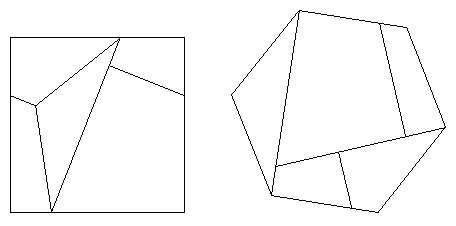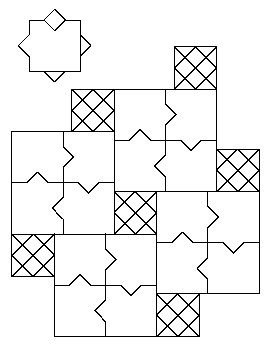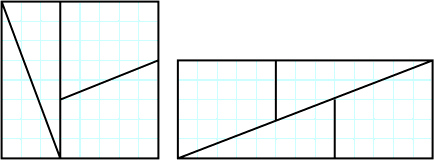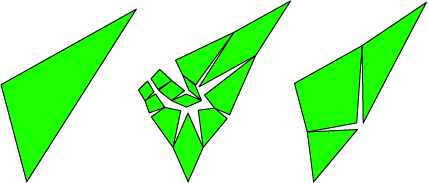
Dissection
This page involves problems of cutting a region (such as a polygon into the plane) into pieces (possibly putting them together to form a different polygon).
Related topics include tiling
(in which the whole plane is cut into pieces)
and triangulation
(in which a region is cut into triangles or higher-dimensional simplices).
- Henry Baker's
hypertext version of HAKMEM
includes a
dissection of square and hexagon, depicted below.
- Cube
Dissection. How many smaller cubes can one divide a cube into?
From Eric Weisstein's
treasure trove of mathematics.
- Dissection challenges.
Joshua Bao asks for some dissections of squares into other figures.
- Dissection and dissection tiling.
This page describes problems of partitioning polygons
into pieces that can be rearranged to tile the plane.
(With references to publications on dissection.)
- Dissection
problem-of-the-month from the Geometry Forum.
Cut squares and equilateral triangles into pieces and rearrange them to
form each other or smaller copies of themselves.
- A dissection puzzle. T. Sillke asks for dissections of two heptominoes into squares, and of a square into similar triangles.
- Dissections. From Eric Weisstein's treasure trove of mathematics.
- Dissections de polygones, réguliers ou non réguliers.
Various polygon dissections, animated in CabriJava.
- Dissections:
Plane & Fancy, Greg Frederickson's dissection book.
Greg also has a list of more links to
geometric
dissections on the web.
- The
equivalence of two face-centered icosahedral tilings with respect to
local derivability, J. Phys. A26 (1993) 1455. J. Roth dissects an
aperiodic three-dimensional tiling involving zonohedra into another
tiling involving tetrahedra and vice versa.
- Fake dissection.
An 8x8 (64 unit) square is cut into pieces
which (seemingly) can be rearranged to form a 5x13 (65 unit) rectangle.
Where did the extra unit come from?
Jim Propp asks about possible three-dimensional generalizations.
Greg
Frederickson supplies one.
See also
Alexander
Bogomolny's dissection of a 9x11 rectangle into a 10x10 square and
Fibonacci
bamboozlement applet.
- Erich Friedman's dissection puzzle.
Partition a 21x42x42 isosceles triangles into six smaller triangles,
all similar to the original but with no two equal sizes.
(The link is to a drawing of the solution.)
- Geometric
Dissections by Gavin Theobald.
- Geometry
corner with Martin Gardner.
He describes some problems of cutting polygons into similar and
congruent parts. From the
MAT 007 I News.
- Hilbert's
3rd Problem and Dehn Invariants.
How to tell whether two polyhedra can be dissected into each other.
See also Walter
Neumann's paper connecting these ideas with problems of
classifying manifolds.
- Hinged dissections of polyominoes
- Hinged kite mirror dissection.
General techniques for cutting any polygon into pieces that can be
unfolded and refolded to form the polygon's mirror image.
- Isosceles
pairs. Stan Wagon asks which triangles can be dissected into
two isosceles triangles.
- Magical
transformations. Wil Laan animates several dissections and almost-dissections.
- Mutations and knots.
Connections between knot theory and dissection of hyperbolic polyhedra.
- No cubed cube.
David Moews offers a cute proof that no cube can be divided into smaller
cubes, all different.
- The Partridge
Puzzle. Dissect an (n choose 2)x(n choose 2)
square into 1 1x1 square, 2 2x2 squares, etc.
The 30-60-90
triangle version of the puzzle is also interesting
- Pi
squared by six rectangle dissected into unequal integer squares
(or an approximation thereof) by Clive Tooth.
- Plates
and crowns. Erich Friedman investigates the convex polygons that
can be dissected into certain pentagons and heptagons having all angles
right or 135 degrees.
- Polyhedral nets and dissection.
David Paterson outlines an algorithm to search for minimal dissections.
- Polyform and dissection puzzle links.
- PolyMultiForms.
L. Zucca uses pinwheel tilers to dissect an illustration of the Pythagorean
theorem into few congruent triangles.
- Polyominoes, figures formed from subsets
of the square lattice tiling of the plane. Interesting problems
associated with these shapes include finding all of them, determining
which ones tile the plane, and dissecting rectangles or other shapes
into sets of them. Also includes related
material on polyiamonds, polyhexes, and animals.
- Proteon's Puzzle Notes
Wen-Shan Kao covers cubes with polyominos and polysticks, packs worms
into boxes, and studies giant tangram like puzzles.
- The
Puzzling World of Polyhedral Dissections.
Stewart T. Coffin's classic book on geometric puzzles,
now available in full text on the internet!
- Pythagorean
theorem by dissection,
part II,
and part III, Java Applets by A. Bogomolny.
- Pythagorean
tilings. William Heierman asks about dissections of rectangles
into dissimilar integer-sided right triangles.
- Rational
square. David Turner shows that a rectangle can only be dissected
into finitely many squares if its sides are in a rational proportion.
- Rec.puzzles archive: dissection problems.
- 75-75-30 triangle dissection.
This isosceles triangle has the same area as a square with side length
equal to half the triangle's long side. Ed Pegg asks for a nice dissection
from one to the other.
- Similar division.
Mineyuki Uyematsu, Michael Reid, and Ed Pegg ask for divisions of given shapes
into pieces, where all pieces must be similar to each other.
- A small puzzle.
Joe Fields asks whether a certain decomposition into L-shaped
polyominoes provides a universal solution to dissections of pythagorean
triples of squares.
- Solution
of Conway-Radin-Sadun problem.
Dissections of combinations of regular dodecahedra, regular icosahedra,
and related polyhedra into rhombs that tile space. By Dehn's solution to
Hilbert's third problem this is impossible for individual dodecahedra
and icosahedra, but Conway,
Radin, and Sadun showed that certain combinations could work.
Now Izidor Hafner shows how.
- Squared
squares and squared rectangles, thorough catalog by Stuart Anderson.
Erich Friedman
discusses several related problems on squared squares:
if one divides a square into k smaller squares,
how big can one make the smallest square?
How small can one make the biggest square?
How few copies of the same size square can one use?
See also
Robert
Harley's four-colored squared square,
Mathworld's
perfect square dissection page, a
Geometry Forum
problem of the week on squared squares,
Keith Burnett's perfect square dissection
page,
and Bob Newman's
squared square drawing.
- Stomachion, a tangram-like shape-forming game based on a dissection of the square and studied by Archimedes.
- Straighten
these curves. This problem from Stan Wagon's
PotW archive
asks for a dissection of a circle minus three lunes into a rectangle.
The ancient Greeks performed
similar
constructions
for certain
lunules
as an approach to
squaring the circle.
- Three cubes to one.
Calydon asks whether nine pieces is optimal for this dissection problem.
- The tiling puzzle games of
OOG. Windows and Java software for tangrams, polyominoes, and polyhexes.
- Tiling a
rectangle with the fewest squares. R. Kenyon shows that any
dissection of a p*q rectangle into squares (where p and q are integers
in lowest terms) must use at least log p pieces.
-
Tiling the unit square with rectangles.
Erich Friedman
shows that the 5/6 by 5/6 square can always be tiled with 1/(k+1) by
1/(k+1) squares.
Will all the 1/k by 1/(k+1) rectangles, for k>0,
fit together in a unit square?
Note that the sum of the rectangle areas is 1.
Marc Paulhus can fit them into
a square of side 1.000000001: "An algorithm for packing squares",
J. Comb. Th. A 82 (1998) 147-157,
MR1620857.
- A tour
of Archimedes' stomachion. Fan Chung and Ron Graham investigate
the number of different square solutions of this dissection puzzle.
- Triangle to a square.
David MacMillan asks geometry.puzzles about this dissection problem.
- Turkey
stuffing. A cube dissection puzzle from IBM research.
- Frank Zubek's
Elusive Cube. Magnetic tetrahedra connect to form dissections of
cubes and many other shapes.
From the Geometry Junkyard,
computational
and recreational geometry pointers.
Send email if you
know of an appropriate page not listed here.
David Eppstein,
Theory Group,
ICS,
UC Irvine.
Semi-automatically
filtered
from a common source file.





